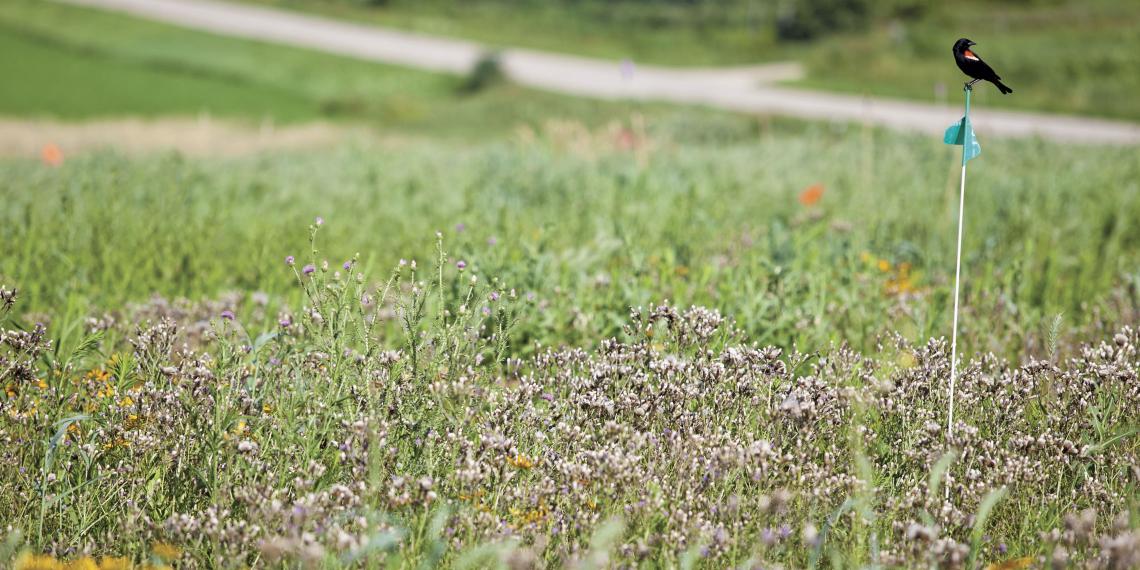
ow can GLBRC researchers be sure that successful fuel production at the lab bench can be scaled up to meet the needs of a state, a region or a country?
One way is to look at the fuel from every angle—counting the inputs related to growing, transporting and converting plant material into fuel. By using robust modeling software, GLBRC researchers are examining the feasibility of potential fuels or technologies not just for scalability, but also for sustainability.
Much more than a buzzword, “sustainable” means that trade-offs—social, environmental and economic factors—have been measured, modeled and validated against actual “boots on the ground data” measured at agricultural research stations and on Midwestern farms, says Randy Jackson, a grassland ecologist and UW-Madison professor of agronomy who co-leads GLBRC’s sustainability research group.
GLBRC research on bioenergy cropping systems, for example, has shown that such crops lead to everything from a reduced need for insecticide (due to an increase in beneficial insects) to increased bird and grassland diversity. “It’s really exciting that these systems offer the opportunity to actually improve both landscape management and ecosystem services, or benefits, that we get from the land,” says Jackson.
For the Center, one such opportunity is the chance to provide research-based recommendations on the most suitable places to grow biofuels crops—an issue that has been the subject of intense debate.
According to a study conducted by GLBRC researchers at Michigan State University, farmers and policymakers should wait before converting Conservation Reserve Program (CRP) land to corn and soybean production.
This study, published in the Proceedings of the National Academy of Sciences in August 2011, shows directly for the first time that the carbon costs of converting CRP lands to corn and soybeans is high – even when care is taken to protect soil carbon from loss by using no-till cultivation practices.
Carbon debt results from carbon dioxide and other greenhouse gases released when land is converted from natural vegetation to agriculture. It's called debt because until a new biofuel crop creates enough renewable fuel to offset the lost CO2, the new biofuel crop has no climate benefit. In fact, it's the same as burning fossil fuel as far as the atmosphere is concerned, says Ilya Gelfand, MSU postdoctoral researcher.
"Conversion creates carbon debt, which must be paid off before the biofuel crop can provide climate mitigation benefits," Gelfand says. "No-till practices (planting without plowing) reduced by two-thirds the amount of debt created by the conversion, but still it would take 29 to 40 years for it to be repaid by growing corn and soybean for biofuel.
Alternatively, growing CRP grasses harvested for cellulosic ethanol would create no debt and provide immediate energy and climate mitigation benefits, he added.
Nationally, more than 30 million acres are set aside as CRP land, and they provide significant climate, wildlife and other conservation benefits, says Phil Robertson, a co-author and MSU professor of crop and soil sciences.
"Growing CRP grasses rather than using the land for corn or corn-soybean production could maintain these benefits indefinitely while providing a valuable bioenergy feedstock," Robertson says. "It could be a win-win for farmers and the environment once a market for cellulosic biofuel develops."
Another way to keep a cap on carbon is to minimize the number of miles that biomass must be transported to the factory gate.
In fact, in order to be economically viable, plant biomass would need to come from an area no more than 50 miles away from where it will be processed into fuel.
A GLBRC team is working to solve biofuel supply chain issues by exploring a new intermediate structure for gathering, processing and converting biomass into cellulosic biofuels. The proposed structures, called Regional Biomass Processing Depots (RBPDs), could improve both the economics and the sustainability of the biomass supply chain by keeping a portion of pretreatment and processing closer to the farm.
“By staging part of the processing closer to where biomass is grown, a distributed model like the RBPDs could help create jobs in rural communities while also transforming plant biomass into an energy intermediate that’s easier to transport,” says Pragnya Eranki, a doctoral student in chemical engineering at Michigan State University (MSU).
At the heart of the supply chain challenge is transportation.
“For cellulosic ethanol, we really don't know what will happen between the field and the biorefinery,” says Bryan Bals, an MSU postdoctoral researcher. “Would it be stored on the farm in bales, sent to a storage facility or sent immediately to the biorefinery? Nobody really has that figured out yet.”
As modeled by the MSU research team, the RBPD concept looks somewhat like a web. Regional depots would be scattered across the state to perform pretreatment, making the biomass more amenable to fuel conversion and compacting it for easier transport to a central biorefinery.
A recent life cycle assessment study conducted by Eranki and Bruce Dale, an MSU professor of chemical engineering, shows that this form of distributed network generates nearly the same net energy as the centralized biorefinery model, but generates significantly lower greenhouse gas emissions.
“If you can create a network of these depots across the country that can densify the biomass, you can ship it across the country without a major increase in cost for transportation,” says Bals.